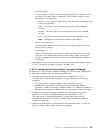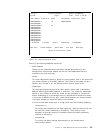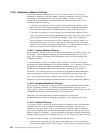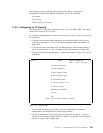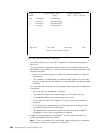To do this, each address in the database has an age assigned to it. When the
address is learned, the age is set to zero. At subsequent time intervals this
address is incremented. There are two system-wide timers which govern the
length of the time the learned entries will be kept in the filtering database:
•
Time-to-Forget
If an address is already in the filtering database and no packets are received
from this source by the Multiprotocol Interconnect module within the
time-to-forget interval, then the address is marked as
forgotten
. Forgotten
entries are no longer used for filtering purposes. They remain in the filtering
database for historical information, until the time-to-delete period expires.
•
Time-to-Delete
After an address is marked as
forgotten
, this parameter determines the
length of the time the entry may remain in memory without being relearned.
If this time expires before any packets are received from the module, the
entry is deleted from the filtering database.
Time-to-forget and time-to-delete are system-wide parameters and can be set by
the user using the
Bridge System Parameters
panel.
11.8.5.2 Operating Modes for Bridging Ports
Each port of the Multiprotocol Interconnect module which is configured for
bridging (TB or SRT) can operate in one of the following two modes:
1.
Normal Mode
In this mode the port can perform the following functions:
•
Can learn new addresses if
Source Address Learning
is enabled for that
port
•
Can forward/filter frames
•
Can communicate with network management software
•
Will participate in spanning tree protocol
2.
Security Mode
In this mode the port can perform the following functions:
•
Can learn new addresses if
Source Address Learning
parameter for that
port is enabled
•
Can forward frame if destination address is permanent or static
•
Can communicate with network management software
•
Will participate in spanning tree protocol if STP is enabled
Note that the difference between normal and security mode is that in security
mode, only the frames destined to stations with permanent entry will be bridged
via the port. You can use the security mode to ensure that the stations attached
to a secure port can communicate with specific stations on the other LANs
through the Multiprotocol Interconnect module.
The mode for each port can be set independently from the other ports. The
setting of the mode is done through the LMS on the
Transparent Bridging Port
Parameters
panel.
Chapter 11. 8260 Multiprotocol Interconnect Module 273





